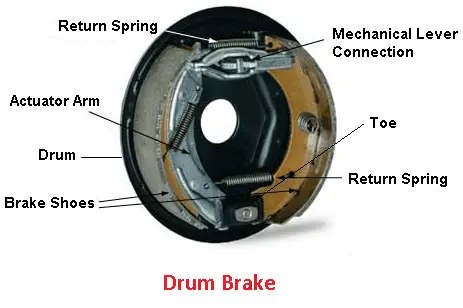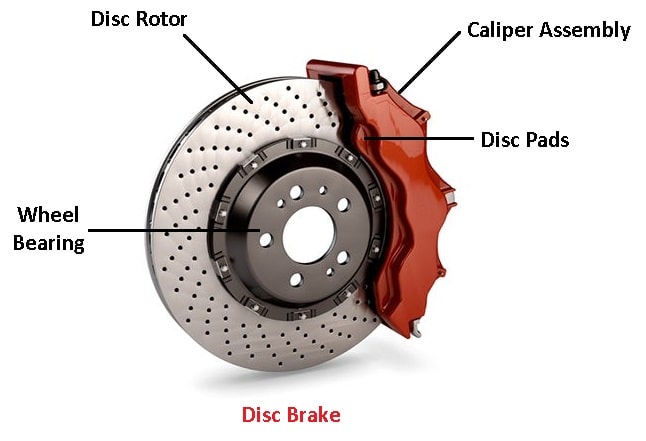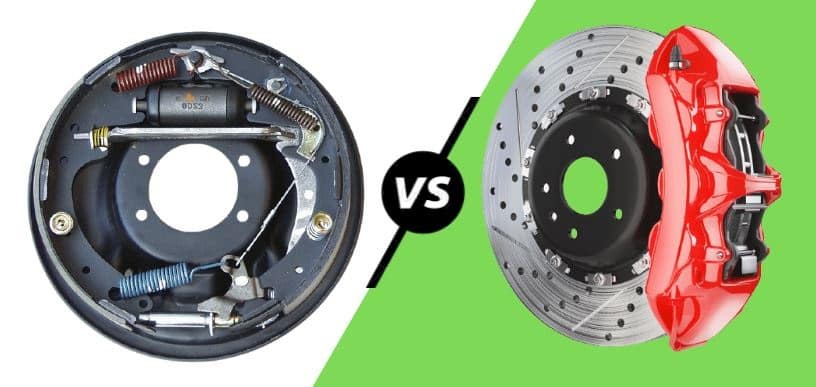In this article, you’ll learn what is drum brake and disc brake? How do they work? And the difference between a drum and disc brake.
Also, you can download a PDF file at the end.
Drum Brake vs. Disc Brake
They are several additional components that are being involved to ensure the car brakes operate smoothly in different road conditions.
A car accident often happens due to a poor braking system. The more you know about this crucial system the better you understand about your vehicle. So, firstly we have to know how this braking system works.
Checkout: What are the different types of braking systems?
Friction and heat are the basic principles applied in the braking system. These are generated during the braking by reducing the speed.
The major brakes currently available are drum brakes and disc brakes. Both have benefits and drawbacks. Today we are comparing them to see what is the better option for your driving conditions.
So, now let’s discuss both the drum and disc braking system and their function.
Read Also: How a Hydraulic Braking System works? [Types, Advantages & Uses]
Drum Brake

It is an ancient and traditional brake system. It is a drum designed like a component where being used for the braking purpose. Inside a drum brake, there is a set of brake shoes.
The brake shoe pushes the drum towards itself when the pedal is pressed and helps reduce vehicle speed. Eventually, the drum brake generates a lot of heat. Due to that heat, the plate may often lose the stopping power, especially in certain braking conditions.
Frequently applying the brakes will leads to increase heat in the braking system. In this condition, the drum brake loses its efficiency due to overheating.
Parts of a Drum Brake
Following are the main parts of a drum brake:
- Brake plate
- Brake drum
- Wheel cylinder
- Brake shoe
#1 Brake Plate
The brake plate is a base component. This increases the rigidity of the entire system, supports the housing, and protects it from foreign materials such as dust, dirt, and other road debris.
The brake plate receives torque from the braking action, and therefore the backplate is also known as the torque plate.
#2 Brake Drum
It is made of a particular type of cast iron that is heat-conductive and wear-resistant. When the brake is applied, the lining pushes against the internal surface of the drum. Hence the friction goes down, and it stops the rotation of the wheel and axle.
#3 Wheel Cylinder
The wheel cylinder consists of two pistons, that operate the shoes on each wheel of the brake. Hydraulic pressure from the master cylinder acts on the piston, pushing the piston against the shoe, and forcing it against the drum.
When the driver presses the brake, the brake shoe springs return the shoes to their original position.
#4 Brake Shoe
The brake shoe is made of steel that is welded together. They are used to slow down or stop the car. They are pushed into the drum to generate friction. The backing is secured to the plate, but the wheel is able to slide when pressure is applied from the wheel cylinder.
Each brake has two shoes. The primary shoe is closer to the front wheel of the vehicle. And the secondary shoe is closer to the rear wheel of the vehicle.
Advantages of Drum Brake
- The parts involved in the drum brake system are pretty easy to manufacture and are also cheaper in cost.
- To apply brakes in your vehicle, the drum brake requires less force.
- Reconditioning the wheel cylinder is easier than reconditioning the calipers on a disc brake.
Disadvantages of Drum Brakes
- It is an enclosed braking system, and due to that, it can collect unwanted foreign particles that cause issues like rusting and reduction in piston performance.
- The drum brakes get wear and tear quite fast due to the high amount of heat. Due to that, the parts of this brake will fail in a very short time.
Read Also: Common Brake Problems That Every Driver Should Know
Disc Brake

The motor vehicles are being fitted with disc brakes. Rather than the conventional type drum brakes, which are commonly used on some cars.
A disc brake usually has a rotating disc and two friction pads. Those are actuated by four hydraulic wheel pistons contained in two halves of an assembly called a caliper.
To apply the brake, the hydraulic pressure is applied to the fluid inlet tube, due to which, wheel cylinder pistons for the friction pads against the rotating disc.
In the released position, the spring holds the piston pads so that they maintain contact with the disc surface. Because the brakes are not self-energizing, more force is needed to apply them for the same brake requirement.
Read Also: What is the function of the Wankel Rotary Engine?
Parts of a Disc Brake
- Brake pads
- Brake rotor
- Caliper
#1 Brake Pads
Each brake caliper consists of two braking pads, each one side of the brake rotor. The brake pad has heat-absorbing properties. There is excessive heat generated due to friction between the brake pads and the rotor. It causes the brake pads to wear in time.
#2 Brake Rotor
When the brake pads come in contact with the brake rotor, the friction force is generated between them. This force is working against the wheel rotation. Actually, it works to slow down or even to stop the moving vehicle.
3. Brake Caliper
It is the main part of the disc brake that helps to move the brake pad to and from the brake rotor.
When you apply the brake, the caliper will push the pads to the rotor hence reducing the speed or stopping the vehicle. When you release the brake, the caliper will pull the pads away from the brake rotor.
Advantages of Disc Brakes
- Smaller size disc brakes also provide significantly larger braking power and can stop high-speed vehicles better than drum brake cans.
- As the disc brakes are open, they become really good at heat dissipation which ensures that they are never hot.
- Being opened they do not hold any unwanted material and so there is no chance of rust or reduction in performance.
Disadvantages of Disc Brakes
- They are costlier to install and produce therefore the overall cost of the vehicle will increase.
- Since they are open, a slight entry of air in the master cylinder can damage the disc brake and cause serious accidents.
Read Also: What are Chassis and Frame? Types of Chassis & Frames
The Main Difference Between Drum and Disc Brake
Following are the difference between drum and disc brake according to their construction, performance, and cost:

#1 Construction
In drum brake, it uses the cylindrical drum. When compared to the disc brake it has a disc-shaped rotor. The drum brake system is a slow braking system. Whereas the disc brake is an instant and fast braking system.
In the case of a drum brake system, it is slower heat dissipation. But in the disc brake, it is faster heat dissipation. In the case of a drum brake, replacing frictional pads is difficult. When compared to a disc brake, the replacement of frictional pads is very easy.
The drum brake uses a hydraulic cylinder to pressurize the friction material against the rotating drum. But in disc brake, uses calipers to hold the friction pad against the rotor disc.
#2 Performance
At a high temperature, the performance of the drum brake will reduce. When compared to the disc brake, In high-temperature conditions, the performance will not affect. Hence, better braking will happen.
The design of the drum brake is complex and is used in trucks, buses, scooters. Whereas the design of disc brake is simple and it is used in modern bikes or cars.
The drum brake is operated mechanically and has a self-locking system. Whereas the disc brake is either operated mechanically or ABS technology and doesn’t have any self-locking system.
In drum brakes, when we stop the vehicle it takes more time that means less efficiency. Whereas in the disc brakes, when we stop the vehicle it takes less time hence is more efficient.
The torque transmission time in drum brakes is less. When compared to a disc brake, the torque transmission time is high.
#3 Cost
Drum brake available with low ventilation power and cheaper cost. But in the disc brake, better ventilation power, and high cost.
In the drum brake system, its weight is more and maintenance cost remains less. But the disc brake is light in weight, and maintenance cost remains high.
Drum brakes use many different fluids in the braking system so there is no need for maintenance. But disc brakes use fluid in the braking system so maintenance is required.
Which one is the best?
Nowadays, most cars with disc brakes in the front wheel and drum brakes on the rear wheel are used. But, the disc brakes are really a good choice because they provide you a better performance in any driving conditions while drum brakes are not.
However, you can’t judge the drum brakes. Because of the low cost and easy maintenance, they can be quite an excellent option for a long time purposes.
Wrapping It Up
That’s it, thanks for reading. I hope that you understand everything about drum brakes and disc brakes. But, If you still have any doubt on this subject, you can ask in the comments.
I hope you like this article, “difference between drum and disc brake“ if yes, then please share it with your friends. Subscribe to our newsletter to get notifications of our new articles.
Download PDF of this article:
Read more differences in our blog: